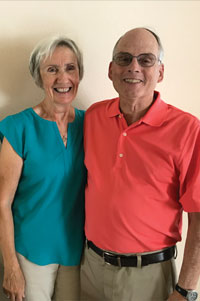 It started with a cough that wouldn’t go away.
It started with a cough that wouldn’t go away.
Tom James and his wife Mary sought answers from their general practitioner, who diagnosed him with pneumonia and prescribed a routine medication. However, the cough persisted. Six months later, an MRI showed that one of Tom’s ribs was inflamed and rubbing on the lung. Additional testing confirmed that it was a plasmacytoma of the rib caused by multiple myeloma. “I remember they called me on July 4, 2006, and told me the news,” Tom said. “We didn’t know what it was, so we looked it up on the internet. Of course, we saw that there’s no cure and that the survival rate isn’t great. It was really scary, especially because we had two young children at the time.”
Tom’s treatment strategy began with radiation before transitioning to a high dose of Revlimid, a therapy accelerated by the Multiple Myeloma Research Foundation (MMRF), ahead of a stem cell transplant in 2007. Especially in those early days, Tom and Mary relied heavily on the MMRF. “The MMRF was really a key source of information to help us understand what we were dealing with and what we could go through. They provided us with hope, too, that typical life expectancies were rapidly improving beyond five years as new therapies were developed.”
Tom is among those who exceeded the 54% probability of a five-year survival rate. Since his transplant, he has been MRD- with no sign of recurrence. “Not everyone is so lucky,” Tom admits. “I’m grateful for the MMRF—over the last 25 years, they helped develop therapies that were beneficial to my care and ensured we understood that there were a number of clinical strategies available.”
Tom and Mary are enjoying retirement now in The Villages, Florida, where they’re able to stay active thanks to many sports and more than 3,000 different hobby groups. Mary is a dedicated quilter, and Tom dabbles in a little bit of everything—including helping neighbors with mechanical repairs and computer support, playing golf, woodworking, and taking classes in programming. In the summers, they head north to New Hampshire to spend time at the lake and visit their adult children and two grandsons, ages 3 and 6.
“We want to see our grandchildren graduate high school,” Tom says. “We’re focused on the best parts of our life and looking to the future.”
In addition to past annual gifts, Tom and Mary give to the MMRF through their IRA; they’ve made the MMRF a key pillar in their long-term giving plans. Tom, an MIT-trained electrical engineer, says the decision was a no-brainer.
“The MMRF, to me, is one of the most unusual organizations that I’ve ever seen from my business experience. They effectively work across academic medical centers, pharmaceutical companies, and biotechs to bring new therapies to market. I’ve personally witnessed how other cancer treatments have changed rapidly over the last ten years, but their progress doesn’t come close to the kind of results the MMRF gets.”
Those results—new therapies, more personalized clinical strategies, and greater access to educational resources—have helped Tom live a life that is not defined by his multiple myeloma. He and Mary both acknowledge that getting to this point, where patients have access to countless clinical trials and more than 15 FDA-approved therapies, wasn’t an easy or inexpensive process.
“It takes a great deal of money to do what the MMRF does,” Tom says. “If you feel like you got something out of the MMRF—as I know I have—giving is a chance to make a tremendous difference for patients living with this cancer today and in the years ahead. No other cancer or research center will have as much of an impact or bring us closer to a cure than the MMRF.”
© Pentera, Inc. Planned giving content. All rights reserved.
Disclaimer